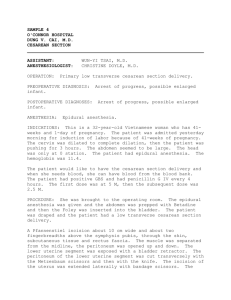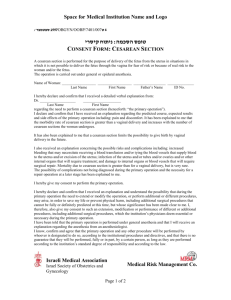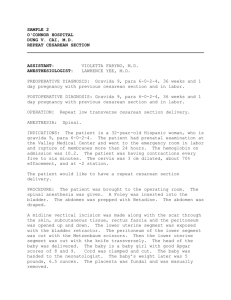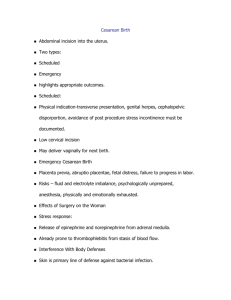Cesarean section 1 Introduction
advertisement
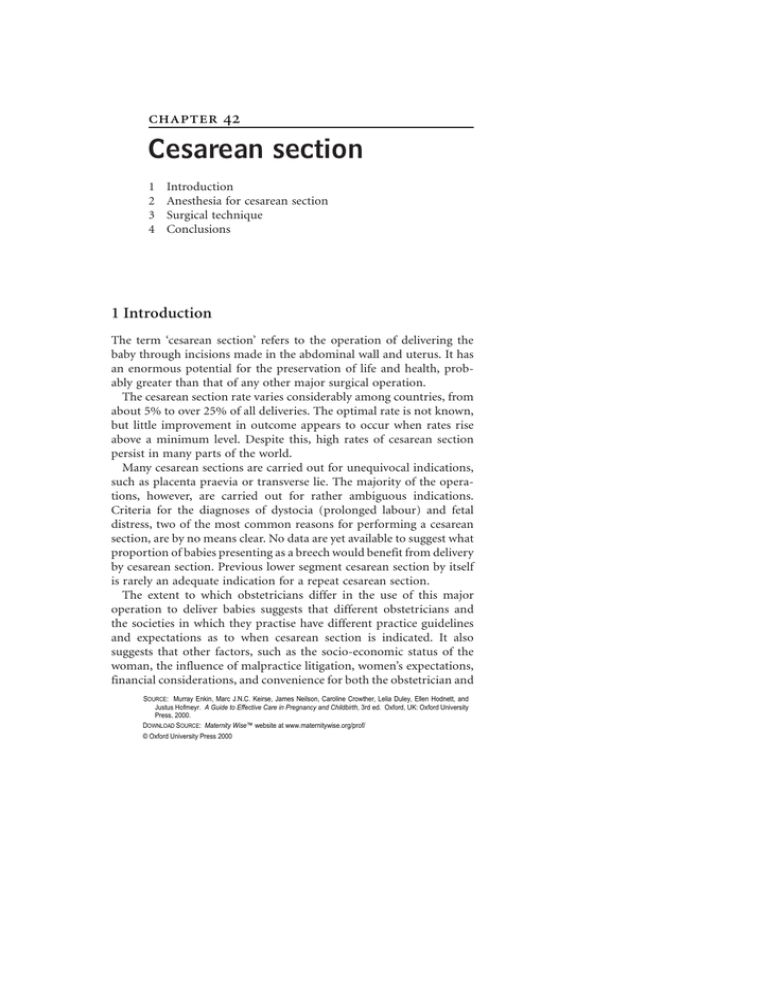
1 2 3 4 5 6 7 8 9 10 1 2 3 4 5 6 7 8 9 20 1 2 3 4 5 6 7 8 9 30 1 2 3 4 5 6 7 8 9 40 41 Cesarean section 1 2 3 4 Introduction Anesthesia for cesarean section Surgical technique Conclusions 1 Introduction The term ‘cesarean section’ refers to the operation of delivering the baby through incisions made in the abdominal wall and uterus. It has an enormous potential for the preservation of life and health, probably greater than that of any other major surgical operation. The cesarean section rate varies considerably among countries, from about 5% to over 25% of all deliveries. The optimal rate is not known, but little improvement in outcome appears to occur when rates rise above a minimum level. Despite this, high rates of cesarean section persist in many parts of the world. Many cesarean sections are carried out for unequivocal indications, such as placenta praevia or transverse lie. The majority of the operations, however, are carried out for rather ambiguous indications. Criteria for the diagnoses of dystocia (prolonged labour) and fetal distress, two of the most common reasons for performing a cesarean section, are by no means clear. No data are yet available to suggest what proportion of babies presenting as a breech would benefit from delivery by cesarean section. Previous lower segment cesarean section by itself is rarely an adequate indication for a repeat cesarean section. The extent to which obstetricians differ in the use of this major operation to deliver babies suggests that different obstetricians and the societies in which they practise have different practice guidelines and expectations as to when cesarean section is indicated. It also suggests that other factors, such as the socio-economic status of the woman, the influence of malpractice litigation, women’s expectations, financial considerations, and convenience for both the obstetrician and SOURCE: Murray Enkin, Marc J.N.C. Keirse, James Neilson, Caroline Crowther, Lelia Duley, Ellen Hodnett, and Justus Hofmeyr. A Guide to Effective Care in Pregnancy and Childbirth, 3rd ed. Oxford, UK: Oxford University Press, 2000. DOWNLOAD SOURCE: Maternity Wise™ website at www.maternitywise.org/prof/ © Oxford University Press 2000 1 2 3 4 5 6 7 8 9 10 1 2 3 4 5 6 7 8 9 20 1 2 3 4 5 6 7 8 9 30 1 2 3 4 5 6 7 8 9 40 41 the woman may sometimes be more important than obstetrical factors in determining the decision to operate. 2 Anesthesia for cesarean section When cesarean section is required, its safety depends on the care with which the anesthetic is administered and the operation performed. Cesarean section can be carried out under either regional (epidural or spinal block) or general anesthesia. Regional anesthesia has many advantages. It largely avoids the risk of regurgitation and aspiration of stomach contents associated with general anesthesia, allows the mother to remain awake, and permits early contact between mother and baby at birth. The main disadvantages of using regional anesthesia for cesarean section relate to the extensive block required for the operation. This may result in a drop in blood pressure, which may require treatment with intravenous fluids and vasopressors. The limited data available from controlled trials show only minor differences in the effects of epidural or spinal anesthesia for cesarean section; spinal resulting in a quicker onset of anesthesia, less shivering with the onset of block, more frequent hypotensive episodes, and no differences in other substantive outcomes. Despite the increasing popularity of regional anesthesia, general anesthesia is sometimes required. Regional anesthesia is contraindicated if the mother has a coagulation disorder. If the reason for the cesarean section relates to a bleeding complication in the mother, the drop in blood pressure with regional anesthesia can be particularly dangerous. General anesthesia can usually be more rapidly administered, and is of value when speed is important, such as when the fetus is in serious jeopardy. Some women prefer to be asleep for the operation. The disadvantages of general anesthesia relate to the serious problems that are sometimes associated with it, such as pulmonary aspiration, inadequate airway control, and neonatal depression. If not managed properly, these can lead to significant maternal and fetal morbidity, and sometimes death. Aspiration of acidic stomach contents can cause acid pneumonitis (Mendelson’s syndrome), the severity of which depends on the acidity of the aspirate (see Chapter 29). The most important measure in preventing pulmonary aspiration is occlusion of the esophagus by cricoid pressure. The maneuver requires an assistant who is knowledgeable and capable. It loses its effectiveness 1 2 3 4 5 6 7 8 9 10 1 2 3 4 5 6 7 8 9 20 1 2 3 4 5 6 7 8 9 30 1 2 3 4 5 6 7 8 9 40 41 unless skilled help is available. Deaths from Mendelson’s syndrome usually result from not applying cricoid pressure, relaxing the pressure before intubation, or applying pressure inefficiently. An equally important problem with general anesthesia arises when the anesthetist is unable to intubate the trachea. Deaths due to aspiration or failed intubation are largely preventable, and can be almost eradicated by improvements in clinical care. Whatever form of anesthesia is chosen, the woman should be in a 15–20 degree lateral tilt position, instead of lying flat on her back. This results in improved neonatal Apgar scores, probably as a result of relieving the pressure of the pregnant uterus on the vena cava and the aorta. 3 Surgical technique Details of operative technique vary from surgeon to surgeon, and few of these techniques have been evaluated in controlled trials. Pulmonary embolism is an important cause of maternal morbidity and mortality with cesarean section. Evidence from other surgical fields shows that this risk can be reduced by the pre-operative use of lowdose heparin, and the available data show no evidence that the use of heparin increases the risk of bleeding with cesarean section. One small trial compared the use of an antiseptic impregnated film with the usual antiseptic scrub technique for skin preparation prior to cesarean section. No differences in infection rates were demonstrated. When a transverse rather than a vertical skin incision is used, average operating time is longer, and more women require blood transfusions. On the other hand, febrile morbidity occurs somewhat less frequently with the transverse skin incision, and most women find the transverse scar more acceptable cosmetically. A modification of the Joel Cohen technique has been compared with the Pfannenstiel technique in one randomized trial. The technique involves a transverse incision through the skin and short transverse incision in the subcutaneous tissue and fascia, which is extended laterally by blunt dissection to minimize bleeding. The peritoneal and subcutaneous layers are not sutured. Blood loss and operating time were significantly reduced in the study group, although postoperative hemoglobin levels were similar. The uterine incision should be made transversely in the lower uterine segment, except in extremely rare circumstances. The initial incision 1 2 3 4 5 6 7 8 9 10 1 2 3 4 5 6 7 8 9 20 1 2 3 4 5 6 7 8 9 30 1 2 3 4 5 6 7 8 9 40 41 is made with a scalpel. Whether scissors or fingers should be used to extend the incision, and whether the suture material or technique used for closure influences the post-operative result, have not been adequately evaluated. No benefits have been demonstrated for the use of a hemostatic stapler for incising the uterus, although the number of women involved in the trials has not been large enough to rule out significant benefits or adverse effects of the technique. Elective manual removal of the placenta at cesarean should be avoided, particularly in Rh-negative women or others where transplacental bleeding might increase the risk of iso-sensitization. The available information from controlled trials suggests that manual removal increases maternal blood loss. The results of single-layer or two-layer closure of the uterine incision are similar, and the time saved by use of a single-layer closure may be worthwhile. A policy of repairing the uterine incision after bringing the uterus out through the abdominal wound seems to have little impact on blood loss compared to one of repairing it within the abdomen, although it may decrease the risk of infective morbidity. It would seem sensible to exteriorize the uterus for repair, if there is difficulty with intra-abdominal exposure. Non-closure of the visceral and/or parietal peritoneum reduces operating time but available evidence does not point to any other clear clinical advantage or disadvantage. There is no evidence of the impact of peritoneal non-closure on longer term outcomes, such as technical difficulties in performing future cesarean sections. The few small trials that have been carried out on other minutiae of operative technique do not provide sufficient data to guide clinical policy. 4 Conclusions Cesarean section is a major operation, with great potential benefit, but also with substantial risks for both mother and baby. The hazards can be kept to a minimum, first, by avoiding unnecessary operations, and, second, by meticulous attention to proper anesthetic and surgical techniques. Consensus by clinicians and consumers by means of evidencebased clinical guidelines and public education may result in more uniform and appropriate use of this major intervention. 1 2 3 4 5 6 7 8 9 10 1 2 3 4 5 6 7 8 9 20 1 2 3 4 5 6 7 8 9 30 1 2 3 4 5 6 7 8 9 40 41 Sources Effective care in pregnancy and childbirth Lomas, J. and Enkin, M.W., Variations in operative delivery rates. Pearson, J. and Rees, G., Technique of caesarean section. Cochrane Library Enkin, M.W. and Wilkinson, C., Lateral tilt for caesarean section. Absorbable staples for uterine incision at caesarean section. Manual removal of placenta at caesarean section. Single versus two layer suturing for closing the uterine incision at caesarean section. Uterine exteriorization versus intraperitoneal repair at caesarean section. Wilkinson, C. and Enkin, M.W., Peritoneal non-closure at caesarean section. Other sources Wallin, G. and Fall, O. (1999). Modified Joel-Cohen technique for caesarean delivery. Br. J. Obstet. Gynecol., 106, 221–6.

